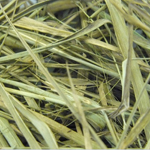The Green Industrial Revolution - Making Biorefineries More Efficient
Media Contact:
Jennifer Martin, (202) 720-8188
By Stacy Kish, CSREES Staff
August 4, 2008

Lignin-rich wood chips used in experiments.
Credit:
Arthur Ragauskas
Biofuels offer a tremendous opportunity to enhance national security, balance trade, increase rural employment opportunities and improve environmental performance by reducing the amount of carbon dioxide gas from internal combustion engine exhaust.
With funding from the USDA's Cooperative State Research, Education, and Extension Service (CSREES) National Research Initiative (NRI), a team of scientists in Georgia developed a new chemical reaction that will make bio-refineries more efficient and effective.
The demand for oil in the United States has increased rapidly during the past 30 years, from 63 quadrillion British thermal units (BTU) in 1970 to 72 quadrillion BTU in 2000. The United States gets about 60 percent of its oil from foreign sources, so the importance of developing alternative renewable sources of energy is obvious -- and it could dramatically reshape agriculture.
A biorefinery is a facility that is tailored to a particular biomass. All parts of the biomass are converted at the refinery to make a range of foods, fuels, chemicals, feeds, materials, heat and power. The renewable biomass may range from switchgrass, to corn, to trees, all rich in lignin, the woody part of the plant cell wall. The potential lignin-based fuel economy may one day replace the petroleum economy and become the primary resource for fuels.
The conversion of complex plant sugars into ethanol -- a biofuel -- has progressed substantially over the past few decades. Through all of the success, scientists have had difficulty developing chemical derivatives to effectively use plant lignin. This portion of plant biomass may hold an opportunity for its potential as a thermal energy resource.
Arthur J. Ragauskas and colleagues at the Georgia Institute of Technology developed a new chemical reaction that converts waste biomass lignin into high-value chemical components. The scientists believe this new reaction will yield high-value, renewable, chemical components derived from lignin. The new products may be used in a variety of products that are currently dependent on petroleum-based resources, as well as improve modern ethanol conversion programs.
"These advancements in fundamental catalytic oxidative chemistry will not only accelerate the development of biofuels, but also could be blended with convention fuels," Ragauskas said.
The chemical reaction is based on the oxidation of lignin. The scientists applied the principles of green chemistry to choose oxidants that are inexpensive, environmentally-benign and renewable feedstocks. Molecular oxygen or hydrogen peroxide is the primary oxidant, with the advantage that the catalysts can be reused at least three times. Recycling and reusing the oxidant in processing lignin reduces the cost of production and minimizes time impact on the environment by reducing the amount of hazardous and toxic byproducts.
Today's bioethanol and biodiesel plants represent the first-generation bio-refineries that use easy-to-process resources, such as sucrose, starches and plant oils. This work expands on this list of substances processed in biorefineries and provides additional options for biofuel production.
CSREES funded this research project through the NRI Biobased Products and Bioenergy Production Research program. Through federal funding and leadership for research, education and extension programs, CSREES focuses on investing in science and solving critical issues impacting people's daily lives and the nation's future. For more information, visit www.csrees.usda.gov.
###
Last Updated: 08/21/2008





